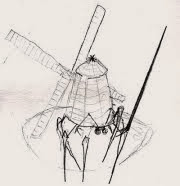Reading paper tape is relatively easy. I've settled on a bank of 'bump sensors' set below the tape. On every third 'heartbeat' tick, the tape is drawn forward one notch, and a set of plungers are bounced with a piano hammer style mechanism against the tape. Where their are holes, a plunger goes through, and triggers the appropiate sensor.
Writing to tape isn't much harder; the plungers have to be solidly built, and driven with a fair amount of force to punch the holes. Nothing impossible.
Now if I could get magical self-healing tape, than I could do reads and writes on the same paper.
Writing on one tape, and reading on the other is monotonous.
Even if I wrote data on the tape backwards from point X, and read program data forwards from point X, the machine will still spend a lot of time spinning tape. Not to mention the overhead in RAM for all the data pointers.
RAM...RAM...RAM...Curse'd RAM...harder to implement than vision. Curs'd, vile, wick'd inquitious RAM !
... Early scrolls could be seen as a form of paper tape, with optical readers, and a reel on each end of the scroll. Of course, the ancients never seem to have invented the cassette to protect the scrolls.
Books - a sector formatted Random Acsess Format - has proved much more useful.
'The Self Propelled Cart' by none other than the talented Leonardo da Vinci is the oldest example of a spring driven mobile mechanism that I can find. Probably was never built, and merely existed as sketches in the Atlanticus Codex.
Recently reconstructed, it should serve as a spur to the 'steampunk' alternate history buffs.
'Reconstructed'? Probably a misnomer. Recently constructed by historians, and made part of a exhibit. To me, the main question is: what was its purpose? The design is functional, blocky, looking more like the guts of a machine. Was there more to it that was never recorded?
The reconstruction is a metre long - this is a large machine. I can't find any estimates to the length of possible run, or speed, or even, for that matter, a good blueprint.
Its interesting to note the 'springs in drums' design of the power springs...practically identical to the springdrums used today.
Recently reconstructed, it should serve as a spur to the 'steampunk' alternate history buffs.
'Reconstructed'? Probably a misnomer. Recently constructed by historians, and made part of a exhibit. To me, the main question is: what was its purpose? The design is functional, blocky, looking more like the guts of a machine. Was there more to it that was never recorded?
The reconstruction is a metre long - this is a large machine. I can't find any estimates to the length of possible run, or speed, or even, for that matter, a good blueprint.
Its interesting to note the 'springs in drums' design of the power springs...practically identical to the springdrums used today.
While selecting an area of one of my photographs, cursing my laziness for not improving my mouse to be able to handle the fine muscle control I needed, it occured to me that it would be a lot easier following a zones perimeter if I had some sort of force feedback. If the texture beneath my mouse changed as the colours changed. What is needed, is a tablet with a surface which can change its friction. Such a material exists: chalk. Under the influence of electricity, damp chalk changes its modolus of friction. This was exploited in a telephone receiver design of Edison's, during the lengthy lawsuits over the critical patents controlling telephony. Probably a number of other materials exhibit this property - this may be fertile ground for some experiments.
Force feedback input devices seem primarly concerned with reading stylus pressure to perform various tasks like line width, line density, colour. Outputting force to the controller seems to be restricted to the 'bump-n-go' style demands of the rumblepack video game controller.
A pity, really. I could work so much faster if I could actually feel the edges of the colour fields.
Force feedback input devices seem primarly concerned with reading stylus pressure to perform various tasks like line width, line density, colour. Outputting force to the controller seems to be restricted to the 'bump-n-go' style demands of the rumblepack video game controller.
A pity, really. I could work so much faster if I could actually feel the edges of the colour fields.
Subscribe to:
Posts (Atom)

